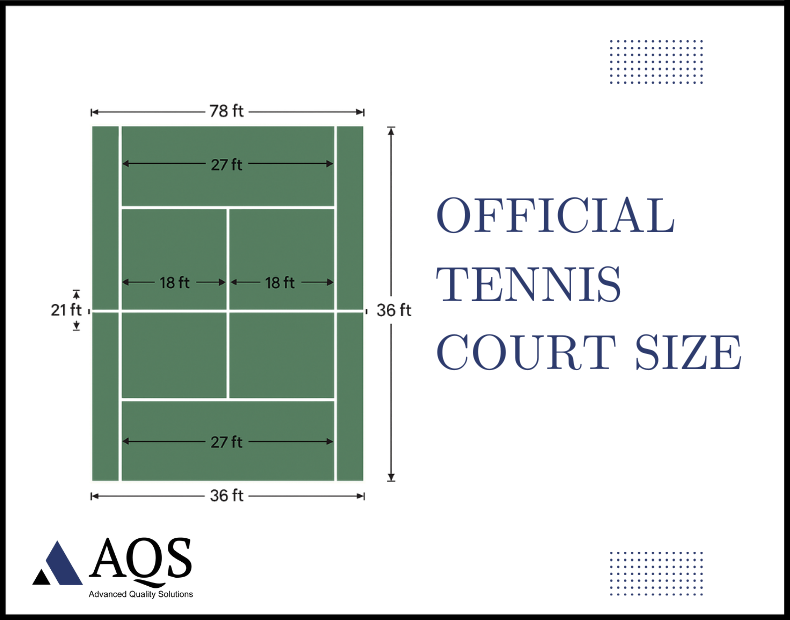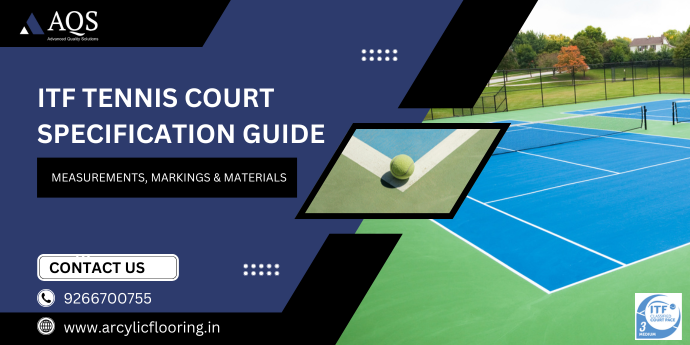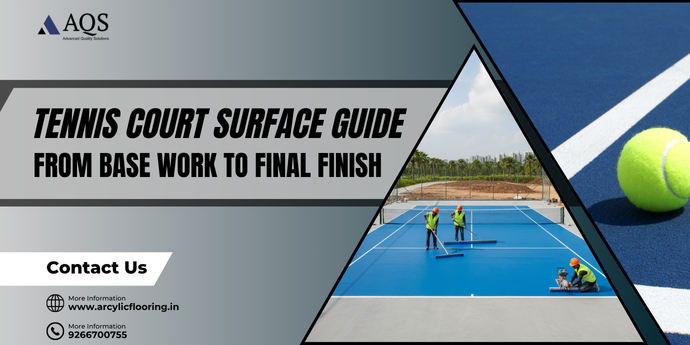Tennis stands out as one of the most popular sports played everywhere from pro arenas to local parks. Whether you’re managing a sports center, starting a training academy, or just want to learn more about it, knowing the Tennis Court Size in square feet is key.
Court size plays a big role in how the game is played, how safe the players are, and even how the court is built. Having the right measurements means having enough space to keep rallies smooth and room for players to succeed. This guide lays out the standard dimensions of tennis courts, shows the differences between singles and doubles courts. Explains how indoor and outdoor courts differ, and highlights why size is so crucial to sports venues.
What Are the Dimensions of a Tennis Court?
The International Tennis Federation sets the standard measurements of tennis courts to ensure they are the same everywhere. A tennis court measures 78 feet in length. The width changes based on whether it’s singles or doubles play. Courts for singles are 27 feet wide, making the playing space 2,106 square feet. For doubles matches, the width increases to 36 feet, providing a playing area of 2,808 square feet.
When discussing Tennis Court Size, remember that the listed dimensions apply to the space within the lines where the game is played. To provide room for safe movement and reduce the risk of injuries, courts need extra space beyond the boundaries. With this additional area included, the recommended total size for a standard tennis court is about 120 feet long and 60 feet wide, adding up to 7,200 square feet. This extra space gives players more freedom to move outside the court’s sidelines and baselines making the play area safer and more suitable for professional use.
Tennis Court Size in Square Feet: Singles vs Doubles
Facility planners often wonder about the size difference between singles and doubles tennis courts. The main distinction is the width of the court. A singles tennis court is 27 feet wide giving enough room for one player per side to move around . This creates a total playing area of 2,106 square feet. A doubles court, on the other hand, is wider at 36 feet. This extra width helps fit two players on each side and increases the total space to 2,808 square feet.
The length stays the same at 78 feet in both singles and doubles formats. However, doubles courts are wider, offering players more space for rallies and tactical shots. Many sports centers prefer building courts with doubles dimensions because these can accommodate both singles and doubles games. This approach makes the courts more useful and saves money over time. Choosing to design larger Tennis Court Size allows facilities to hold different types of matches without needing extra setups.
Indoor vs Outdoor Tennis Court Size
The size of a tennis court flooring stays the same indoors or outdoors. However, the area around the court needs to change depending on whether it is indoors or outside. Outdoor courts need extra room to install fences, set up lights, and ensure drainage during rain. To include runoff space, an outdoor tennis court takes up around 7,200 square feet.
Indoor courts need to consider things like ceiling height, airflow, and extra room on the sides to allow seating or storage. The ceiling has to be tall enough at least 40 feet, so players can serve and hit lobs without any issues. When you add features like stands for spectators and space to store equipment indoor setups might need an area surpassing 8,000 or even 9,000 square feet. Although the size within the court’s boundaries doesn’t change, designers of sports facilities must plan these additional needs carefully to meet all standards and keep the courts functional.
Tennis Court Size for Different Levels of Play
While the ITF establishes the official tennis court dimensions to follow in professional play, not all venues need to stick to those rules. Courts made for tournaments meet ITF guidelines with precision. They include full runoff areas, spots for spectators, and spaces for media, which makes their overall size almost 8,000 square feet.
Community or recreational courts might cut down on runoff areas because of space limits. They still keep the official court size between the lines. Schools and training centers often tweak the overall space to match what they have but ensure the playing zone stays the same. This adjustment helps bring tennis to more places without needing the large areas required by pro setups. However, keeping the proper court size is crucial. It ensures fair play and good practice conditions for everyone, no matter the skill level.

Mini Tennis and Kids’ Court Sizes
For Kids, the ITF set up smaller court sizes to match what young players can handle. These mini tennis courts let children build their skills and get ready to play on full-sized courts as they grow older. For kids between 5 and 8 years old, the red stage uses courts that are 36 feet long and 18 feet wide adding up to 648 square feet. The orange stage, aimed at kids aged 8 to 10, increases the court size to 60 feet by 21 feet, with a total area of 1,260 square feet.
By the green stage when kids are around 9 or 10 years old, the court uses the regular singles tennis court size of 78 feet by 27 feet covering 2,106 square feet. These stages make the game easier for children to play and help them build the skills. They need to move into regular gameplay without difficulty. To teach tennis from an early age, sports academies and schools can use mini courts to create a fun and safe learning space.
Why the Right Tennis Court Size Is Important
Making tennis courts the right size is about more than following international rules. The size of the tennis court has an impact on how the game is played. With a measured court, players can move , play shots without limits, and enjoy fair competition. Safety matters too. Courts that lack enough extra space at the edges can cause players to trip, crash, or get hurt while running after the ball.
To design sports facilities and academies, getting right tennis court sizes is important to use space well and plan costs better. A facility built to proper tennis court measurements attracts players, holds tournaments, and stays useful over the years. Correct tennis court dimensions also meet the requirements to host official tournaments. As professional tennis matches happen on ITF-approved tennis courts. Tennis Court size is not just a technical aspect but plays a big role in making a sports facility successful.
Mistakes People Make When Measuring Tennis Courts
Even with clear global rules, building tennis courts often involves errors. A common mistake happens when tennis court builders skip considering runoff areas and only think about the space within the playing lines. This might save money or make the court fit on a smaller property. But it affects both safety and how well the tennis court can be played on.
Another frequent issue is mixing up the tennis playing space with the overall tennis court dimensions. This can cause planners to misjudge how much land is needed. Sometimes, tennis courts end up with wrong sizes because of mistakes converting between meters and feet. Which makes them unfit for official tournaments.
Facilities often ignore the need to plan space for fencing, lighting, and areas for spectators leading to problems down the line. To prevent these issues, it is important to plan and review ITF standards in the process. Focusing on total tennis court layout helps sports facilities avoid expensive mistakes and meet global standards.
Thinking About More Than Just Tennis Court Dimensions
The right tennis court dimensions is important, but many other factors affect the quality of a tennis court. The type of tennis surface material plays a big role in a player’s experience. Acrylic synthetic flooring options last longer and need less care. While clay and grass courts give a different playing experience but need more attention. A good drainage system is key for outdoor tennis courts to stop water from pooling. Which can harm the court and interrupt matches.
Good tennis court slope design makes rainwater drain away from the tennis court fast. The lighting setup also matters a lot when tennis courts are used in the evening. LED lights with even brightness improve visibility and reduce glare, which makes games more enjoyable. Tennis court facilities also need space to include fences, seating areas, and walkways to give the place a professional look. Along with choosing the proper Tennis Court Size, all these factors turn a simple court into a full sports facility.
Conclusion
Choosing the right Tennis Court Size in square feet is key to ensuring fair play, safety, and smooth running of the facility. From singles to doubles tennis courts, indoor to outdoor courts, and even small courts for kids’ mini tennis, each has its own role.
For sports facilities, following ITF standards is not just about compliance, it’s an investment in performance, and long-term usability. Whether you’re building a court for a school, academy, or professional tournament, knowing the exact court size helps you plan better court.
AQS offers best tennis court materials and third-party installation experts who install tennis court with proper tennis court measurement. Contact Us Now for tennis court!
Frequently Asked Questions
A standard doubles tennis court, including runoff, is about 7,200 sq. ft.
A singles court playing area measures 2,106 sq. ft., but total facility space should still match doubles standards.
Yes, runoff areas may be reduced, but the playing area must remain standard.
The playing area is within the lines; the total area includes safety zones around the court.
Multiply 7,200 sq. ft. per court by the number of courts you plan to build, adding extra for pathways, seating, and amenities.




